Wondering how much well water you need for your home?
Assessing well flow rate and yield is important when you’re considering drilling a well on your property or you’re thinking of reinstalling an existing well.
In fact, the volume of water that a well can supply is just as important as the water quality, since poor flow or water yield may be inadequate to meet your demands.
Here, we’ve shared the most important information about well water capacity and flow rate, including how to calculate capacity, how to determine flow rate, and what to do if your well yield isn’t substantial for your home.
📌 Key Takeaways:
- A well’s yield and flow rate is a measure of how much water is drawn from the well per minute.
- A good flow rate for a private well for residential use is around 6 to 12 gallons per minute, or 100-120 gallons per day.
- You can calculate water well yield/flow rate with several methods, including the bucket test.
Table of Contents
- 🚰 What Are Well Water Flow Rate And Yield?
- 📈 Why Is Well Water Yield & Flow Rate Important?
- 🔢 How To Calculate Well Flow Rate Or Yield
- 🧮 How To Calculate Well Water Capacity
- ✅ What’s A Good Well Water Flow Rate & Water Yield?
- 🤔 What Happens If Water Yield And Flow Rate Aren’t Adequate?
- 📉 What To Do If Your Well Yield Falls Short
- 📑 Final Word
🚰 What Are Well Water Flow Rate And Yield?
The flow rate of water in a well is the volume of water that the well pump draws up from the well aquifer.
A well’s yield is the maximum rate (in gallons per minute) of water that can be pumped from the well at its current size and capacity.
A well’s capacity is a measure of the volume of water that the well can store at any time.
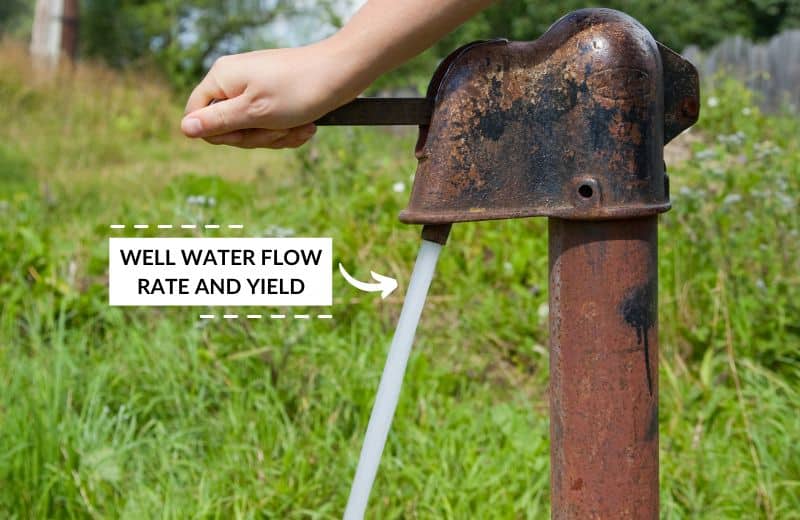
📈 Why Is Well Water Yield & Flow Rate Important?
Well water yield and flow rate are important because they determine the volume of water you have access to every day (measured in gallons per minute).
Assessing a well’s flow rate and yield will help you to determine whether a well can provide you with an adequate water supply for your water usage and demands.
A private well for residential use should be able to provide enough water for all purposes around your home, including shower water, drinking water, cooking water, and water for all appliances and fixtures.
You can compare your well’s flow and yield to a good flow rate to determine its suitability as a domestic water source.
🔢 How To Calculate Well Flow Rate Or Yield
As we mentioned, the flow rate of a well is the volume of water that comes from the well, and is measured in gallons per minute (GPM). The faster the pump draws water, and the more water that’s pumped at a time, the higher the flow rate.
You should have information on your well pump’s flow rate in your well records. But if you don’t, you can calculate flow rate with a well flow test.
There are a few different ways to determine your well’s flow rate. We recommend the bucket test, since it’s the easiest method.
Here’s what to do:
Step 1: Gather Your Equipment
Start by gathering the equipment you need for your calculations.
You’ll need a 5-gallon bucket, a stopwatch (your phone will do), and access to a fixture that’s closest to water’s point of entry into your home – ideally an outdoor faucet.
Step 2: Conduct The Test
Next, follow these steps to work out your water well flow rate from the pump:
- Open a faucet nearest to the well, then wait until the pump kicks in.
- Once you hear the pump turn on, close the faucet and wait for the pump to fill the pressure tank.
- When the pump shuts off, open the faucet and measure the number of gallons of water that’s discharged before the pump kicks in again. You might need more than one bucket.
- Once this happens, turn off the faucet and start your stopwatch. Time the pump cycle (aka. how long the pump stays on to fill the pressure tank), stopping when the pump switches off.
- Divide the number of gallons of water you collected by the number of seconds of the pump cycle.
- Multiply this figure by 60, which will give you the average flow rate, of pumping capacity, of the well pump in GPM.
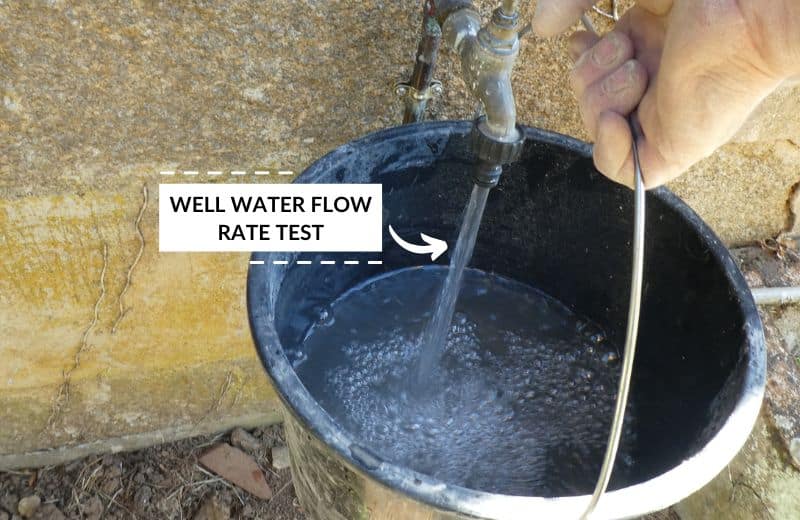
The Quickest Method
The quickest way to get a good idea of your well’s flow rate is to use a pressure gauge to take a water pressure reading, then convert water pressure to flow.
So, if your well water pressure reads between 40 and 60 PSI (pounds per square inch), the flow rate will be around 5-8 GPM.
🧮 How To Calculate Well Water Capacity
To work out well capacity or water volume, here’s what you need to do:
Step 1: Gather Your Information
You’ll need to know your well diameter, your well depth, and the depth to water (in feet).
If this information isn’t available in your well records, you can easily measure your well diameter and depth yourself. Read our full guide on how to measure well depth for detailed instructions.
Step 2: Do The Math
Subtract the depth to water from the overall well depth, then do the following equation: pi (or 3.15 if you’re not using a calculator) multiplied by the square of the well radius multiplied by the well height.
Example: let’s say your well is 10 feet deep and 1 foot to water, with a 2 foot diameter.
You would begin by subtracting 1 from 10 (your well depth to water from the overall well depth) to make 9.
You’d then divide 2 (your well diameter) by 2 to get a 1-foot radius, then multiply that by pi, followed by the well height of 9 feet. The final figure is your well volume in cubic feet.
Here’s what the sum looks like
10-1 = 9
V = (3.15_(2)(2))/4_9 = 28.3 cubic feet
You can then multiply the cubic feet total by 7.47, which makes 211 gallons – the total number of gallons in your well volume.
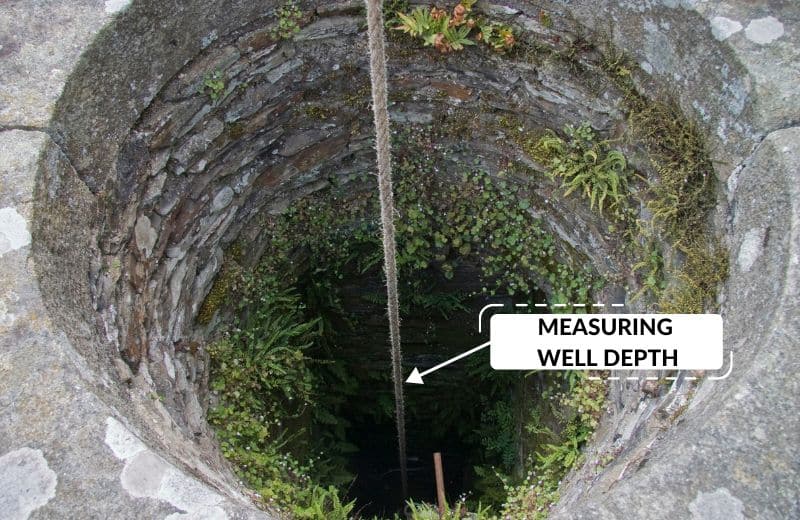
✅ What’s A Good Well Water Flow Rate & Water Yield?
The average American household needs a whole home water flow rate of around 6 to 12 gallons per minute, or around 100-120 gallons per day. This requirement depends on your family size and the number of fixtures/appliances in your home.
At the very minimum, a well water system that consistently supplies water at a 5 GPM flow rate should be able to meet peak demand with daily use in most homes.
Domestic wells with a lower flow rate may still be able to meet daily demand, but they might not meet demand during peak usage periods.
🤔 What Happens If Water Yield And Flow Rate Aren’t Adequate?
If your water yield is low or your well flow is below the minimum flow rate recommended to meet peak demand, you may notice the following problems in your home.
Inefficient Appliances
Your appliances and water treatment equipment require a minimum flow of water to operate efficiently.
If you have slow water flow rates from your well, your plumbing system may be unable to supply enough water to your water heaters, washing machines, dishwashers, and treatment equipment, affecting their performance.
Some appliances won’t operate at all if the water pressure or flow rate isn’t high or fast enough.
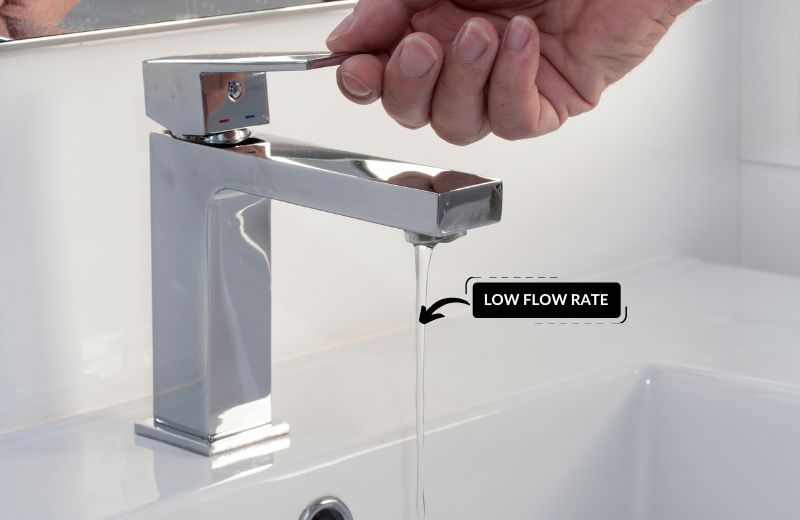
Inadequate Water Flow From Faucets & Fixtures
A slow well water flow rate or low water yield will reduce the volume of water flowing through your plumbing fixtures.
You might find that there’s only a low volume of water that leaves your faucets and showers, even when you turn them on full.
Inability To Use Multiple Appliances At Once
Your well water supply might be inadequate to meet your water demand, to the point where you’re unable to use multiple fixtures or appliances at once.
For example, if your well flow rate is slow, you might get only a trickle of water if you try to switch on your shower while your washing machine is running.
📉 What To Do If Your Well Yield Falls Short
It’s all very well knowing about well yield and flow before you drill a well – but what if you already have a well that isn’t supplying the water you need?
If your well yield or flow rate don’t meet the recommended standards, you can take some measures to improve flow.
Some possible options include:
- Buy a bigger well pump. If your well yield is adequate but your pump flow rate is too low, you can increase flow by sizing up. A bigger pump equals a bigger pump intake, meaning that the pump can draw a larger volume of water to your home per minute. Buying a larger and more powerful pump is the easiest way to boost water flow to meet peak demands.
- Install a water storage tank. Again, if your well pump’s flow rate is low, another option is to install a storage tank. Storage tanks can hold around between 20 and 120 gallons, and they deliver water under pressure into your plumbing system. You can install a pressure booster pump if you need to increase the flow of water from the tank into your home.
- Increase your well volume. We recommend looking into hydro-fracturing (or hydrofracking), which is when rock and fine particles from bedrock fractures are flushed within the well. This increases the space for water in the bedrock to flow into the well.
- Increase the well diameter or depth. You can also increase the diameter of your well to increase its water storage capacity. This won’t affect your water quality because you’ll be drawing water from the same aquifer, but increasing the well’s diameter isn’t a good option if you live in a region with fluctuating water levels. In this case, deepening the well might be the best solution.
- Dig a separate well. If you get your well professionally inspected and the contractor deems it unsuitable for enlarging with hydrofracking, the only solution to meet your water demand may be to dig a separate well on the property.
Related: 11 well water conservation tips
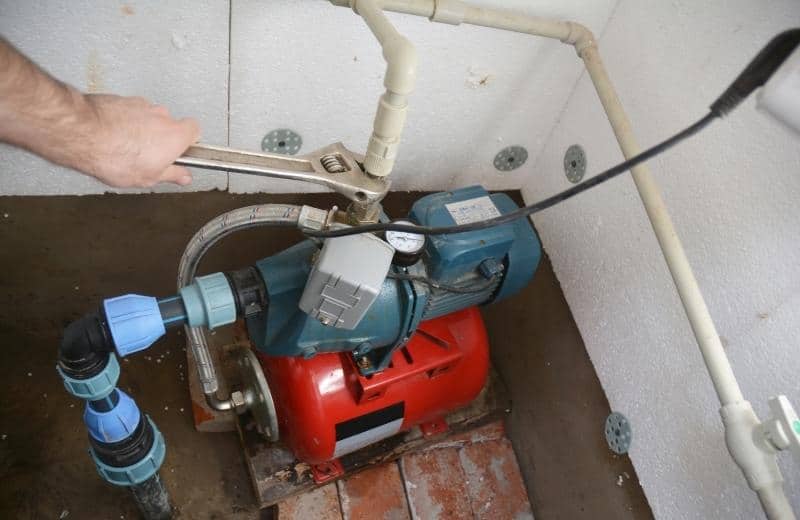
📑 Final Word
Adequate well yield and flow rate are essential to meet your water needs even during peak demand.
Hopefully, you now know how to assess these two indicators and determine a suitable flow or yield from your well water system.
👨🏼🔧 Want to learn more on this topic? We’ve also written about the best water pressure for a well.
